The Wide World of Mexican Eggs
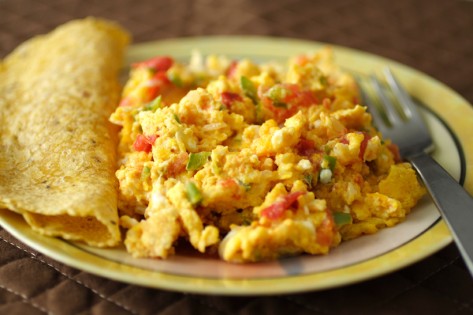
Mexicans must eat a lot of eggs. The range and styles of egg dishes available to the Mexican cook makes those of her American neighbors to the north seem bland and limited by comparison.
The basic cooking methods will seem familiar: fried, scrambled, poached, prepared as an omelets. It’s the south-of-border ingredients, and the treatment of them—such as broiling tomatoes or chiles to making a sauce with deep, roasted flavors—that make Mexican egg dishes an exciting change from our repertoire in the U.S.—and a more flavorful way to start the day. Some of the more transformative preparations, like Brick Layers Eggs, may even appeal to those who, claim they do not like eggs.
I was considering calling this posting “Eggs Beserke” because I made so many of the eggs dishes in The Art of Mexican Cooking, in part because we keep chickens and have a surfeit of fresh eggs and because I found the names of the dishes charming: Ranch Eggs, commonly known by its Spanish name Huevos Rancheros, Estate Eggs, Emperor Cuauhtemoc Eggs, Bricklayer’s Eggs, and, from Diana Kennedy’s newest book Oaxaca al Gusto, Shoemaker’s Eggs.
Though the five egg dishes I made, shown below, are diverse, each uses the all-important chile—fresh or dried. Often the fresh chiles—serranos and poblanos—are broiled before being used and the dried chiles—pasillas and guajillos—are toasted to heighten flavor before being resuscitated in water and then ground in a blender to form a sauce. I found the chile guajillos particularly beautiful. When held up to the light, it has a vellumlike translucency, and the color is a vibrant, deep ruby red.
- Serrano and poblano chiles. The general rule is the smaller the chile, the hotter it is. So, as you can imagine, the large poblano is not very hot at all, particularly once the seeds and membranes are removed.
- Dried chiles used for Brick Layer’s Eggs: chile pasillas (left) and chille guajillos (right)
- A chile guajillo, split open and held up to the light
1. Mexican Scrambled Eggs. (See photo, top of posting.) In this simple but delicious scramble, made with onions, tomatoes and serranos, the chiles are not broiled but quickly sauteed, lending the dish a brighter, vegetal flavor than the egg dishes made with broiled tomatoes and chiles. (Diana Kennedy states that many cooks simply stir the raw chile, onion, and tomato into the eggs, which would give an even more greater vegetal flavor and crunch). Because this dish is simple, it highlights the flavor of the eggs more than some of the other more complex recipes.
2. Eggs Scrambled with Chorizo and Tomato. After Mexican Scrambled Eggs, this egg dish tastes most of eggs. In fact, you could think of it like Mexican Scrambled eggs. It too is made with sauteed onion and tomato, but in this case the serrano is swapped out for chorizo for an earthier type of chile heat. The over-riding flavor, and chile heat, of this simple dish depends on the quality and spiciness of the chorizo.
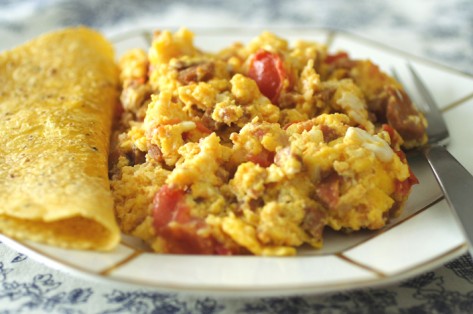
3. Ranch Eggs. Known as Huevos Rancheros in Spanish, this is the most well-known egg dish outside of Mexico. It can be made with either salsa verde (shown in the foreground) or the tomato-based salsa ranchera. Once the salsa verde or salsa ranchera is made, and the poblano roasted, peeled, and cut into “ragas,” the rest of the work is mostly that of assembly: A fried corn tortilla is topped with a fried egg, then some sauce, a few chile strips, and then finally some crumbled cheese.
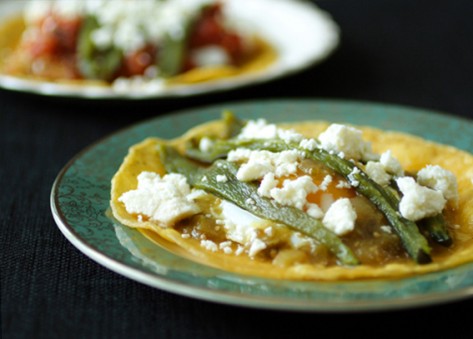
4. Estate Eggs. This preparation is a more elaborate (and very filling) version of Ranch Eggs, with the addition of refried beans and Chihuanhua or Muenster cheese. A rich dish, it is a great choice for a special Sunday brunch.
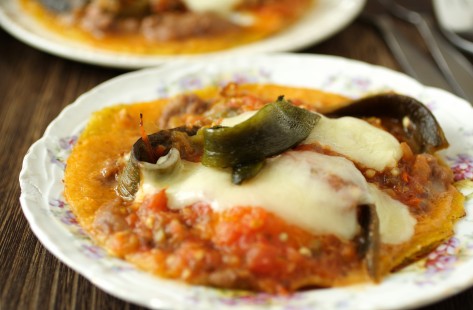
5. Brick Layer’s Eggs. In this dish the eggs are cooked in a brick-red sauce made dried chiles and topped with queso fresco and chopped white onion. Cooked until the sauce is fairly dry, this recipe transforms the eggs into pure protein. They could easily be mistaken for tofu, making this the perfect dish for those who don’t like eggs.
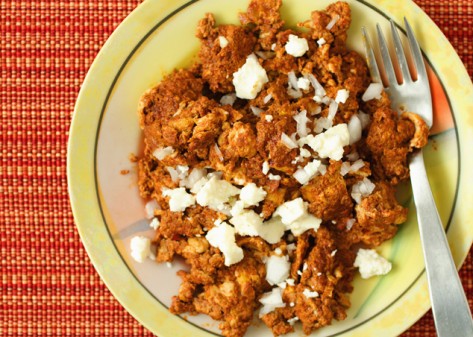
Note: In The Art of Mexican Cooking, the use of eggs is not limited to recipes in the egg chapter. You will find eggs used as a key binding, protein, and/or rising component in several savory and sweet recipes in the non-egg chapters as well: Dried Beef Hash, one of my favorites in the book, Dried Beef Filling with Scrambled Eggs, Fava Beans with Eggs, Vicki’s Egg Custard, Egg Sponge in Syrup, Almond Dessert, and two flan recipes.

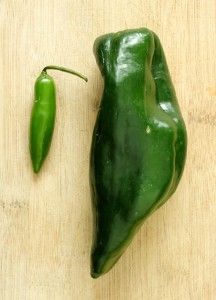

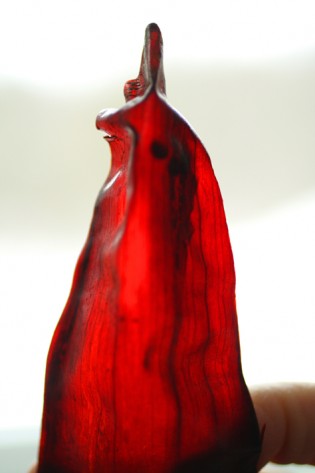
Makes me salivate — I can’t wait for the garden to get going. Well, I have sorrel now, which goes well with eggs. Will I try to squeeze in some eggs before I go to yoga? I shouldn’t.
1And, I had never realized that the smaller the hotter. You learn something new every once in awhile.
For me the egg recipes in this book have been a wonderful surprise. And since I’m not ambitious enough in the morning to cook a hot meal, we’ve enjoyed eggs for dinner. One of my favorites was the Eggs Scrambled with Chorizo and Tomato, and definitely, the key to this dish’s flavor and texture was the chorizo. I tried it first with more of a chile seasoned sausage which was called chorizo, but in retrospect I don’t think it was really very Mexican at all. The second time I made the dish, having been frustrated with not being able to find the kind of chorizo I imagined should be used, I decided to make my own following the chorizo de huetamo recipe on page 266; an adventure that warrants a discussion of its own but suffice it to say, as you suggest, it made a world of difference in the dish.
2You made chorizo! That is amazing. How wonderful and inspiring. I’ve never made homemade sausage, but have wanted to for some time. If you have time, please let me, and any other readers out there, know more about the recipe–specifically, if you made any adjustments or if it went off as is without a hitch.
3I’m very, very impressed.
I’ve never had sorrel and eggs together. Now I have yet another way to enjoy eggs, thanks to your tip. The world of eggs is now even wider.
4